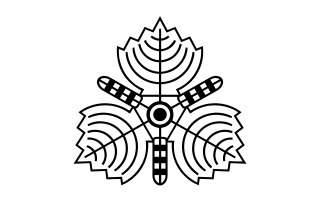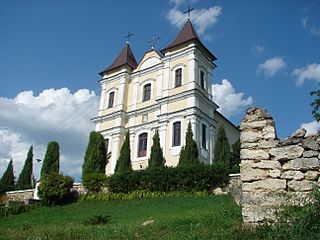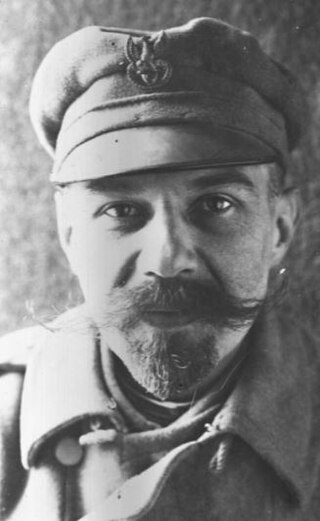
Sakhalin is an island in Northeast Asia. Its north coast lies 6.5 km (4.0 mi) off the southeastern coast of Khabarovsk Krai in Russia, while its southern tip lies 40 kilometres (25 mi) north of Japan's Hokkaido. A marginal island of the West Pacific, Sakhalin divides the Sea of Okhotsk to its east from the Sea of Japan to its southwest. It is administered as part of Sakhalin Oblast and is the largest island of Russia, with an area of 72,492 square kilometres (27,989 sq mi). The island has a population of roughly 500,000, the majority of whom are Russians. The indigenous peoples of the island are the Ainu, Oroks, and Nivkhs, who are now present in very small numbers.

Maximilian Maria Kolbe was a Polish Catholic priest and Conventual Franciscan friar who volunteered to die in place of a man named Franciszek Gajowniczek in the German death camp of Auschwitz, located in German-occupied Poland during World War II. He had been active in promoting the veneration of the Immaculate Virgin Mary, founding and supervising the monastery of Niepokalanów near Warsaw, operating an amateur-radio station (SP3RN), and founding or running several other organizations and publications.

Polish people, or Poles, are a West Slavic ethnic group and nation who share a common history, culture, the Polish language and are identified with the country of Poland in Central Europe. The preamble to the Constitution of the Republic of Poland defines the Polish nation as comprising all the citizens of Poland, regardless of heritage or ethnicity. The majority of Poles adhere to Roman Catholicism.

The Polish diaspora comprises Poles and people of Polish heritage or origin who live outside Poland. The Polish diaspora is also known in modern Polish as Polonia, the name for Poland in Latin and many Romance languages.

Karafuto Agency, from 1943 Karafuto Prefecture, commonly known as South Sakhalin, was a part of the Empire of Japan on Sakhalin, it was part of the gaichi from 1907 to 1943 and later a prefecture as part of the naichi until 1945.

Niepokalanów monastery is a Roman Catholic religious community situated in Teresin. It was founded in autumn 1927 by Friar Minor Conventual – Maximilian Kolbe, who was later canonized as a saint-martyr of the Catholic Church.

Poles in Kazakhstan form one portion of the Polish diaspora in the former Soviet Union. Slightly less than half of Kazakhstan's Poles live in the Karaganda region, with another 2,500 in Astana, 1,200 in Almaty, and the rest scattered throughout rural regions.

There is a long history of Poles in Azerbaijan. Although the current Polish population of the Republic of Azerbaijan is lower than in former times, the number of people with Polish descent in the capital city Baku is around 2,000 and several thousand self-identified Poles live in Azerbaijan. Poles as an ethnic group have lived in Azerbaijan for centuries. The Russian Empire included Azerbaijan and parts of Poland, thus it could deport members of opposition of Polish nationality there, which explains the presence of Poles in Azerbaijan.
St. Casimir Church is a parish church of the Roman Catholic Archdiocese of Baltimore located in the Canton neighborhood of Baltimore, Maryland.

The history of Poles in Moldova has to be examined keeping in mind the traditional borderline along the Dniester river which separates Bessarabia from Transnistria in Moldova. While the regions on both sides of the river were socially and culturally interconnected, the distinct political histories of the two territories resulted in different patterns of Polish settlement there.
Polish settlement in the Philippines began during the Spanish colonial period, mostly with the arrival of Catholic clergy destined for missionary work in other Asian countries. As of 2010 the 2010 census, there are 93 persons in the Philippines who claim Polish citizenship, and the Polish community in the Philippines is the fourth-largest Central European community in the country, after the local communities of Germans, Hungarians and Albanians.

The Monument to the Fallen and Murdered in the East is a monument in Warsaw, Poland which commemorates the victims of the Soviet invasion of Poland during World War II and subsequent repressions. It was unveiled on 17 September 1995, on the 56th anniversary of the Soviet invasion of 1939.
A Polish Paraguayan is a Paraguayan-born person of full or partial Polish ancestry or a Polish-born citizen who resides in Paraguay. The peak of Polish immigration to Paraguay began during the 20th century, particularly after World War II when millions of Poles left their country and chose different countries where they could find a better quality of life. In South America, Paraguay was one of the main destinations.
Kazimierz Grochowski (1873-1937) was a Polish mining engineer, explorer, geologist, ethnographer, archaeologist, and writer specializing in studies of Siberia, Mongolia, and Manchuria.

Japan–Poland relations refers to the bilateral foreign relations between Japan and Poland. Both nations enjoy historically friendly relations, embracing close cooperation and mutual assistance in times of need. Both are members of the OECD, World Trade Organization and United Nations.

Mongolia–Poland relations are bilateral relations between Mongolia and Poland. The countries enjoy good relations, based on growing trade, and political and investment cooperation. Both nations are full members of the OSCE, World Trade Organization and United Nations.

Polish Peruvians are Peruvian-born citizens who are of fully or partially of Polish descent, whose ancestors were Poles who emigrated to Peru as part of the Polish diaspora or Polish-born people in Peru.

Poles in China form a small population, estimated at 1,000 and mostly concentrated in the major cities of Beijing, Guangzhou, Hong Kong and Shanghai. First noted Polish people lived in China in the 17th century.

Poles in Buryatia form part of the Polish diaspora in Siberia. Polish presence in Buryatia dates back over 300 years.

James Douglas was a diplomat and Polish independence activist.

















